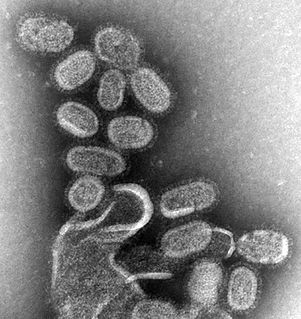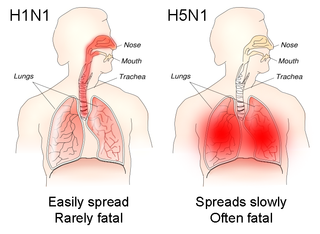Related Research Articles
Antiviral drugs are a class of medication used for treating viral infections. Most antivirals target specific viruses, while a broad-spectrum antiviral is effective against a wide range of viruses. Unlike most antibiotics, antiviral drugs do not destroy their target pathogen; instead they inhibit their development.

Avian influenza, known informally as avian flu or bird flu, is a variety of influenza caused by viruses adapted to birds. The type with the greatest risk is highly pathogenic avian influenza (HPAI). Bird flu is similar to swine flu, dog flu, horse flu and human flu as an illness caused by strains of influenza viruses that have adapted to a specific host. Out of the three types of influenza viruses, influenza A virus is a zoonotic infection with a natural reservoir almost entirely in birds. Avian influenza, for most purposes, refers to the influenza A virus.

Influenza vaccines, also known as flu shots or flu jabs, are vaccines that protect against infection by influenza viruses. New versions of the vaccines are developed twice a year, as the influenza virus rapidly changes. While their effectiveness varies from year to year, most provide modest to high protection against influenza. The United States Centers for Disease Control and Prevention (CDC) estimates that vaccination against influenza reduces sickness, medical visits, hospitalizations, and deaths. Immunized workers who do catch the flu, return to work half a day sooner on average. Vaccine effectiveness in those under two years old and those over 65 years old remains uncertain due to a lack of high quality research. Vaccinating children may protect those around them.

Live attenuated influenza vaccine (LAIV) is a type of influenza vaccine in the form of a nasal spray that is recommended for the prevention of influenza. In June 2016, the Centers for Disease Control and Prevention (CDC) stopped recommending the use of LAIV as its effectiveness had appeared to have decreased between 2013, and 2016, but this recommendation was reversed in February 2018, for the 2018-2019 influenza season.

Swine influenza is an infection caused by any one of several types of swine influenza viruses. Swine influenza virus (SIV) or swine-origin influenza virus (S-OIV) is any strain of the influenza family of viruses that is endemic in pigs. As of 2009, the known SIV strains include influenza C and the subtypes of influenza A known as H1N1, H1N2, H2N1, H3N1, H3N2, and H2N3.

Seasonal influenza vaccine brands include Fluzone/Fluzone Quadrivalent and Vaxigrip/VaxigripTetra, Influvac and Optaflu.

Flu season is an annually recurring time period characterized by the prevalence of outbreaks of influenza (flu). The season occurs during the cold half of the year in each hemisphere. Influenza activity can sometimes be predicted and even tracked geographically. While the beginning of major flu activity in each season varies by location, in any specific location these minor epidemics usually take about three weeks to reach its pinnacle, and another 3 weeks to significantly diminish.

An influenza pandemic is an epidemic of an influenza virus that spreads across a large region and infects a large proportion of the population. In contrast to the regular seasonal epidemics of influenza, these pandemics occur irregularly. There have been five influenza pandemics during the last 140 years, with the 1918 Spanish flu pandemic being the worst; this pandemic is estimated to have been responsible for the deaths of 50–100 million people. The most recent, the 2009 swine flu pandemic, resulted in under a million deaths and is considered relatively mild.

Influenza A virus subtype H3N2 (A/H3N2) is a subtype of viruses that causes influenza (flu). H3N2 viruses can infect birds and mammals. In birds, humans, and pigs, the virus has mutated into many strains. In years in which H3N2 is the predominant strain, there are more hospitalizations.
A breakthrough infection is a case of illness in which a vaccinated individual becomes sick from the same illness that the vaccine is meant to prevent. Simply, they occur when vaccines fail to provide immunity against the pathogen they are designed to target. Breakthrough infections have been identified in individuals immunized against a variety of different diseases including Mumps, Varicella, and Influenza. The character of breakthrough infections is dependent on the virus itself. Often, the infection in the vaccinated individual results in milder symptoms and is of a shorter duration than if the infection was contracted naturally.

Influenza, commonly known as "the flu", is an infectious disease caused by an influenza virus. Symptoms can be mild to severe. The most common symptoms include: high fever, runny nose, sore throat, muscle and joint pain, headache, coughing, and feeling tired. These symptoms typically begin two days after exposure to the virus and most last less than a week. The cough, however, may last for more than two weeks. In children, there may be diarrhea and vomiting, but these are not common in adults. Diarrhea and vomiting occur more commonly in gastroenteritis, which is an unrelated disease and sometimes inaccurately referred to as "stomach flu" or the "24-hour flu". Complications of influenza may include viral pneumonia, secondary bacterial pneumonia, sinus infections, and worsening of previous health problems such as asthma or heart failure.

The 2009 swine flu pandemic was an influenza pandemic that lasted for about 19 months, from January 2009 to August 2010, and was the second of two pandemics involving H1N1 influenza virus. First described in April 2009, the virus appeared to be a new strain of H1N1, which resulted from a previous triple reassortment of bird, swine, and human flu viruses further combined with a Eurasian pig flu virus, leading to the term "swine flu".
The 2009 flu pandemic in the United States was a novel strain of the Influenza A/H1N1 virus, commonly referred to as "swine flu", that was first detected on 15 April 2009. Later that April, both the World Health Organization and the Obama administration declared a public health emergency.

This article covers the chronology of the 2009 novel influenza A (H1N1) pandemic. Flag icons denote the first announcements of confirmed cases by the respective nation-states, their first deaths, and relevant sessions and announcements of the World Health Organization (WHO), the European Union , and the U.S. Centers for Disease Control (CDC).

In 1976, an outbreak of the swine flu, influenza A virus subtype H1N1 at Fort Dix, New Jersey caused one death, hospitalized 13, and led to a mass immunization program. After the program began, the vaccine was associated with an increase in reports of Guillain-Barré Syndrome, which can cause paralysis, respiratory arrest, and death. The immunization program was ended after approximately 25% of the population of the United States had been administered the vaccine.

In virology, the pandemic H1N1/09 virus is a swine origin influenza A virus subtype H1N1 strain that was responsible for the 2009 swine flu pandemic. This strain is often called swine flu by the public media. For other names, see the Nomenclature section below.

The 2009 flu pandemic vaccines were influenza vaccines developed to protect against the pandemic H1N1/09 virus. These vaccines either contained inactivated (killed) influenza virus, or weakened live virus that could not cause influenza. The killed vaccine was injected, while the live vaccine was given as a nasal spray. Both these types of vaccine were produced by growing the virus in chicken eggs. Around three billion doses were produced, with delivery in November 2009.
Cell-based vaccines are developed from mammalian cell lines rather than the more common method which uses the cells in embryonic chicken eggs to develop the antigens. The potential use of cell culture techniques in developing viral vaccines has been widely investigated in recent years as a complementary and alternative platform to the current egg-based strategies.

The 2017–2018 United States flu season lasted from late 2017 through early 2018. The predominant strain of influenza was H3N2. During the spring months of March–May, influenza B virus became dominant.

US influenza statistics by flu season. From the Centers for Disease Control and Prevention page called "Disease Burden of Influenza": "Each year CDC estimates the burden of influenza in the U.S. CDC uses modeling to estimate the number of influenza illnesses, medical visits, flu-associated hospitalizations, and flu-associated deaths that occur in the U.S. in a given season. The methods used to calculate these estimates are described on CDC’s webpage, How CDC Estimates the Burden of Seasonal Influenza in the U.S."
References
- 1 2 "CDC - Seasonal Influenza (Flu) - Selecting the Viruses in the Influenza (Flu) Vaccine". Cdc.gov. Retrieved 2013-09-24.
- ↑ "CDC - Seasonal Influenza (Flu) - Vaccine Virus Selection for the 2012-2013 Influenza Season". Cdc.gov. Retrieved 2013-09-24.
- ↑ Declan Butler. Vaccine decisions loom for new flu strain. 12 May 2009 Nature. 12 May 2009. News. doi:10.1038/459144a